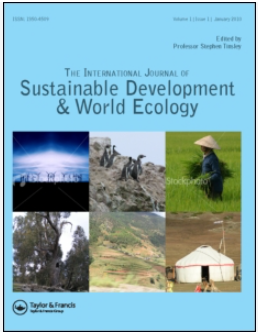Framework of ecological infrastructure construction based on landsenses ecology: meeting natural and human needs
IF 7.7
3区 环境科学与生态学
Q1 ECOLOGY
International Journal of Sustainable Development and World Ecology
Pub Date : 2023-05-05
DOI:10.1080/13504509.2023.2209871
引用次数: 0
Abstract
ABSTRACT Ecological infrastructure (EI) is an essential urban infrastructure that is not only related to ecological resilience but the human needed ecosystem services. However, most studies overlook EI’s multi-functional benefits, especially the importance of residents’ satisfaction. As a typical nature-based solutions (NbS) through ecological engineering, EI construction should abide by the laws of nature and consider the requirements of human well-being. Based on the theory of landsenses ecology (LE), this study proposes a framework, including construction ideas, approaches, principles, and construction flow, to guide the whole process of EI construction, meeting natural and human needs. Moreover, a practice including EI facilities and an Internet of Things (IoT) monitoring system construction has been taken in Sangdong, Huizhou, Guangdong-Hong Kong-Macao Greater Bay Area (GBA), China. The practice study indicates that the proposed framework of EI construction can successfully restore the regional ecological environment quality and play a significant role in restoring the black-odorous waterbodies to their original ecological vitality. Secondly, using social surveys to thoroughly analyze residents’ physical, psychological, and cultural perceptions and integrating their visions into the EI design scheme can improve residents’ satisfaction and support human well-being. Besides, IoT technology is helpful for digital EI supervision, dealing with real-time, online, and quantitative benefit evaluation and management. This paper focuses on practical exploration and experience sharing of how EI construction meets natural and human needs, aiming at providing experience and ideas for adequate urban ecological infrastructure (UEI) construction to support human and nature development hand in hand.基于景观生态学的生态基础设施建设框架:满足自然与人文需求
摘要生态基础设施(EI)是一种重要的城市基础设施,不仅关系到城市的生态恢复能力,也关系到人类所需要的生态系统服务。然而,大多数研究忽视了情商的多功能效益,尤其是居民满意度的重要性。EI建设作为一种典型的基于自然的生态工程解决方案,应遵循自然规律,考虑人类福祉的要求。本研究以景观生态学理论为基础,提出了一个框架,包括建设理念、建设方法、建设原则和建设流程,以指导EI建设的全过程,满足自然和人类的需求。此外,在中国粤港澳大湾区惠州、山东等地开展了包括EI设施和物联网(IoT)监控系统建设的实践。实践研究表明,提出的EI建设框架能够成功地恢复区域生态环境质量,对恢复黑臭水体原有生态活力具有重要作用。其次,通过社会调查深入分析居民的身体、心理和文化感知,并将他们的愿景融入到EI设计方案中,可以提高居民的满意度,支持人类福祉。此外,物联网技术有助于数字化EI监管,处理实时、在线、定量的效益评估和管理。本文着重对城市生态基础设施建设如何满足自然和人的需求进行实践探索和经验分享,旨在为城市生态基础设施建设提供经验和思路,以支持人类和自然的共同发展。
本文章由计算机程序翻译,如有差异,请以英文原文为准。
求助全文
约1分钟内获得全文
求助全文
来源期刊
CiteScore
11.10
自引率
3.60%
发文量
58
审稿时长
18-36 weeks
期刊介绍:
The International Journal of Sustainable Development and World Ecology is now over fifteen years old and has proved to be an exciting forum for understanding and advancing our knowledge and implementation of sustainable development.
Sustainable development is now of primary importance as the key to future use and management of finite world resources. It recognises the need for development opportunities while maintaining a balance between these and the environment. As stated by the UN Bruntland Commission in 1987, sustainable development should "meet the needs of the present generation without compromising the ability of future generations to meet their own needs."

 求助内容:
求助内容: 应助结果提醒方式:
应助结果提醒方式:


